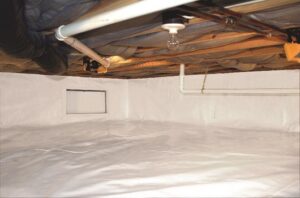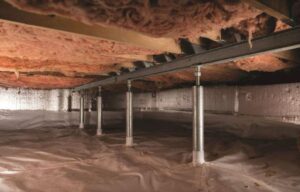Crawlspaces are often the unsung heroes of a home’s foundation, serving as vital spaces for utilities, ventilation, and access to plumbing and wiring. However, these spaces are also susceptible to moisture issues, which can lead to a wide range of problems, from structural damage to mold growth and indoor air quality concerns. Crawlspace waterproofing is the key to safeguarding your home from these issues and ensuring a dry, healthy, and structurally sound environment. In this comprehensive guide, we’ll explore the importance of crawlspace waterproofing, the common issues that can arise in crawlspaces, and various methods to effectively protect this essential part of your home.
The Importance of Crawlspace Waterproofing
Crawlspace waterproofing is more than just preventing water from entering your home’s lower space; it plays a pivotal role in maintaining the overall well-being and longevity of your property. Here are some compelling reasons why waterproofing your crawlspace is essential:
Structural Integrity: The moisture in crawlspaces can damage the structural components of your home’s foundation, including wooden support beams, floor joists, and the foundation walls. Moisture can lead to rot and decay, compromising the strength and stability of your home.
Mold and Mildew Prevention: Dark, damp, and often neglected, crawlspaces are ideal breeding grounds for mold and mildew. The growth of these fungi can lead to health issues and affect the indoor air quality of your home.
Pest Control: A moist crawlspace can attract pests like termites and rodents, which can cause extensive damage to your home and introduce health hazards.
Energy Efficiency: A damp crawlspace can lead to increased humidity levels, which can affect your home’s energy efficiency. It can make heating and cooling less effective and result in higher energy bills.
Home Value: A well-maintained and waterproofed crawlspace is an attractive feature for potential homebuyers. On the contrary, a wet and moldy crawlspace can significantly decrease your property’s value and deter prospective buyers.
Common Crawlspace Issues
Before delving into crawlspace waterproofing methods, it’s crucial to understand the common issues that can arise in crawlspaces. Recognizing these problems can help you take timely action to protect your home. Some of the typical crawlspace issues include:
Excess Moisture: Moisture can enter crawlspaces through a variety of ways, including groundwater infiltration, leaks from plumbing or drainage systems, and even high humidity levels.
Standing Water: In some cases, crawlspaces can accumulate standing water, especially in areas with poor drainage or heavy rainfall. This standing water can result in a host of issues, including mold growth and structural damage.
Mold and Mildew: Crawlspaces are dark, humid spaces that create ideal conditions for mold and mildew to thrive. These fungi can damage your home and pose health risks.
Pest Infestations: Damp crawlspaces attract pests like termites, rodents, and insects. These pests can cause structural damage and spread diseases.
Odors and Poor Indoor Air Quality: The musty odors and air quality problems associated with crawlspaces can affect your overall living environment and even lead to respiratory issues.
Crawlspace Waterproofing Methods
Now that we understand the importance of crawlspace waterproofing and the issues it can prevent, let’s explore various methods to protect your crawlspace effectively:
Vapor Barriers
Vapor barriers are one of the most common and cost-effective methods of crawlspace waterproofing. They are typically made of polyethylene plastic and are installed on the floor and walls of the crawlspace to prevent moisture from entering the space. Vapor barriers work by creating a physical barrier that moisture cannot penetrate. This method is particularly useful in preventing moisture from the ground or from concrete walls.
Encapsulation
Crawlspace encapsulation takes waterproofing a step further by sealing the entire crawlspace. This method involves covering the floor, walls, and ceiling of the crawlspace with a heavy-duty, puncture-resistant liner. It is often used in conjunction with a dehumidifier to control humidity levels in the crawlspace. Encapsulation creates a sealed, moisture-proof environment that prevents water intrusion, moisture, and mold growth. It also serves as an effective barrier against pests.
Drainage Systems
In cases where water tends to accumulate in the crawlspace, the installation of a drainage system can be a valuable addition to your waterproofing efforts. A perimeter drainage system, similar to what is used in basements, can be installed to collect and redirect water away from the crawlspace. The collected water is then pumped out of the crawlspace using a sump pump. Proper grading and slope adjustments around the crawlspace can also help prevent water from pooling near the foundation.
Dehumidification
Crawlspace dehumidification is essential for controlling humidity levels in the space. High humidity can contribute to mold growth and compromise the effectiveness of vapor barriers and encapsulation. Installing a dehumidifier in the crawlspace helps maintain optimal humidity levels, ensuring a dry and healthy environment.
Foundation Vent Sealing
In some regions, crawlspaces are equipped with vents to allow airflow. However, in many cases, these vents can actually introduce moisture and humidity into the crawlspace, especially during periods of high humidity or rainfall. Sealing foundation vents can help prevent the entry of excess moisture and improve crawlspace waterproofing.
French Drains
French drains, a common solution for addressing drainage issues around a home’s foundation, can also be utilized in crawlspaces. These drains consist of a perforated pipe surrounded by gravel and are installed in trenches. They effectively collect and channel water away from the crawlspace, helping to keep it dry.
Insulation Upgrades
Adding or upgrading insulation in the crawlspace can help regulate temperature and prevent condensation, which can contribute to moisture issues. Properly insulating the crawlspace can help maintain a stable temperature and reduce the risk of humidity-related problems.
Regular Maintenance
Finally, regular maintenance is a critical aspect of crawlspace waterproofing. Periodic inspections and upkeep can help identify issues before they become major problems. This may include checking for leaks, ensuring that drainage systems are functioning properly, and monitoring the condition of vapor barriers and encapsulation.
Crawlspace waterproofing is a fundamental aspect of home maintenance that often goes overlooked. However, its significance cannot be overstated. A dry and properly maintained crawlspace is essential for protecting your home’s structural integrity, indoor air quality, and overall well-being.
With a variety of effective methods available, from vapor barriers and encapsulation to drainage systems and dehumidification, homeowners have the means to safeguard their crawlspaces. Preventing moisture intrusion, mold growth, and pest infestations not only ensures the longevity and value of your property but also contributes to a healthier and more comfortable living environment. If you’ve neglected your crawlspace, or suspect that it may be in need of waterproofing, it’s time to take action and invest in the protection and preservation of your home.
Contact the Professionals at Seal-Tite Basement Waterproofing Today! 540-992-1144

Seal-tite Basement Waterproofing Co. is a full service basement environment contractor. We carry an A+ Better Business Bureau rating. We repaired over 40,000 homes and structures in Virginia, West Virginia, Tennessee, and North Carolina. We are fully insured and licensed. We have worked in all types of locations, including residential and commercial locations, government agencies, colleges, hospitals, churches, and condo associations.
Seal-tite® offers a lifetime transferable warranty. We carry a Class A Contractor’s License and we are fully insured. Our satisfied customers range from government agencies to businesses, hospitals, colleges, churches, and thousands of homeowners. Your home is probably the single largest investment you will make in your lifetime. Don’t wait, call Seal-tite® to help make your home dry, safe and livable.


 Call or email for a free estimate. For immediate help call
Call or email for a free estimate. For immediate help call  Start with trust. We’re BBB A+ Rated The Top Satisfaction Rate Awarded.
Start with trust. We’re BBB A+ Rated The Top Satisfaction Rate Awarded.